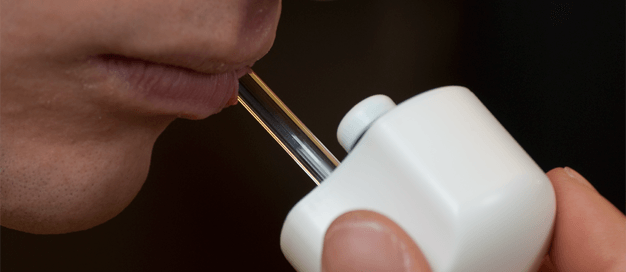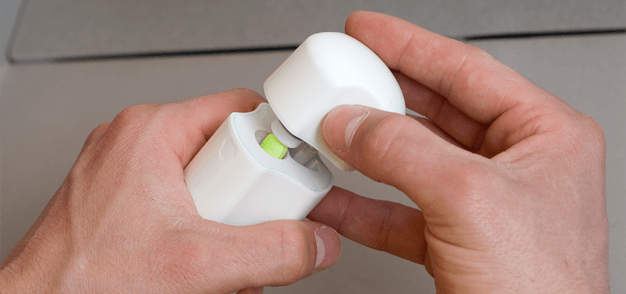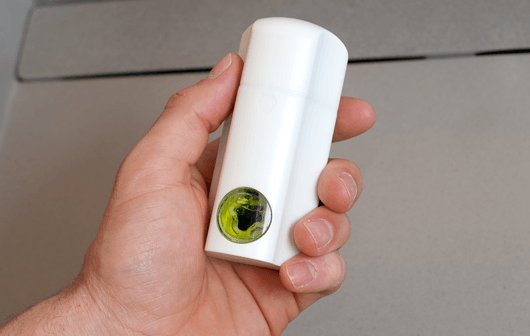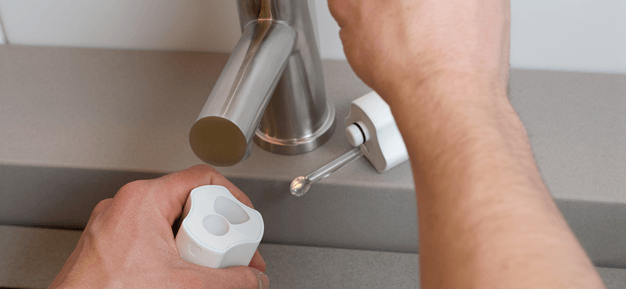Bacteria are traditionally perceived as infectious and unhealthy, but that is about to change. This week designer Jan van der Asdonk graduated from the Next Nature Lab at the TU/e Industrial Design Masters with a speculative yet full fledged product proposal called the FluDOC, which uses glowing bacteria to detect human influenza.
The product uses genetically modified bioluminescent bacteria which are sensitive to influenza as a detector, somewhat similar to the canaries that were once used in coalmines to detect potentially dangerous gasses.
The FluDOC consists of a casing and a small stick which the user can use to collect salivia from the mouth, after which an liquid capsule of the bioluminescent bacteria is entered. If the saliva contains an influenza virus the bacteria will die within 15 minutes and stop emitting their continuous flow of light, which the user can simply read of the display.
The personal influenza test would typically be used if you don't feel well but are unsure if you have influenza or merely a cold. Such self diagnosis could contribute to an early detection and containment of infectious influenza viruses.
Here is how it works
 Step 1. Enter the liquid capsule containing the influenza sensitive bioluminescent bacteria.
Step 1. Enter the liquid capsule containing the influenza sensitive bioluminescent bacteria.
 Step 2: Gathering the saliva from your mouth using the saliva-stick.
Step 2: Gathering the saliva from your mouth using the saliva-stick.
 Step 3: Close the product by securing the cap, which penetrates the liquid capsule and brings the bacteria in contact with the salvia.
Step 3: Close the product by securing the cap, which penetrates the liquid capsule and brings the bacteria in contact with the salvia.
 Step 4: After 15 minutes the user can read the display. In this case the center element in the glass – containing the bacteria that have been in contact with the salvia – has become dark. This means you have cached an influenza virus.
Step 4: After 15 minutes the user can read the display. In this case the center element in the glass – containing the bacteria that have been in contact with the salvia – has become dark. This means you have cached an influenza virus.
 Step 5: Clean out the product and put away for future use. Stay home in bed or go to work depending on the outcome of the test.
Step 5: Clean out the product and put away for future use. Stay home in bed or go to work depending on the outcome of the test.
Ready to order?
Not really. It will take some years before the FluDOC enters the consumer market, as the modified bacteria required for the product have not yet been engineered.
The FluDOC was created to explore the application space of Synthetic Biology, an emerging research field in which bacteria are turned into tiny little factories at the disposal of man – similar to the domestication of cows and chicken which were bred and optimized to become efficient factories of human food production some 10.000 years ago, only on a smaller scale.
Within the realm of synthetic biology, we have already been discussing bacteria that eat waste and shit petrol, turn CO2 into energy, or eat plastic, but the FluDOC is the first consumer product that employs engineered bacteria.
Obviously, we still need to position ourselves in this biotech future, as it is yet unclear if we are designing the penicillin or asbestos of the 21th century. Speculative products like the FluDOC, could help envisioning this future including some of threads and opportunities.
The final thesis by Jan van der Asdonk can be downloaded as a PDF here.


Comments (0)
Share your thoughts and join the technology debate!
No comments yet
Be the first to share your thoughts!